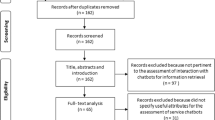Abstract
Many age-associated impairments such as loss of memory and vision make computer use difficult for older adults. This paper is concerned with interface design in a voice Web browser, which compensates for age-associated impairments, particularly loss of memory and vision. It describes a special Voice Help facility talking to older adults through their browser interaction, and reports experiments to establish the mixes of output media (text and speech) that are most effective for information transfer. In particular, the paper demonstrates that older adults’ retention of spoken output is different to that of younger people. The paper provides information on absorption rates for different media for older adults, which supports the design of multimodal systems suited to older adults. This is important for the development of systems that enable older adults to absorb information easily.
Similar content being viewed by others
References
Czaja S, Clarke C, Weber R, Nachbar D (Oct 1990) Computer communication among older adult. In: Proc The Human Factors and Ergonomics Society 33rd Annual Meeting, Denver, USA, pp 146–148
Gardner DK, Helmes E (1999) Locus of control and self-directed learning as predictors of well-being in the elderly. Aust Psychol 34(2):99–903
Gregor P, Newell A, Zajicek M (2002) Designing for dynamic diversity – interfaces for older people. In: Jacko JA (ed) ASSETS 2002, 5th International ACM Conference on Assistive Technologies, 8–80 July, Edinburgh, Scotland 2002, pp 151–156
Kalyuga S (2000) When using sound with text or picture is not beneficial for learning. Aust J Educ Technol 16(2):161–172
Park DC (1998) Ageing and memory: mechanisms underlying age differences in performance. Aust J Ageing 17(1):69–92
Rabbitt P (1997) The Alan Welford memorial lecture – ageing and human skill: a 40th anniversary. Ergonomics 40(10):962–281
Stuart-Hamilton I (1999) Intellectual changes in late life. In: Woods E., R.T. Psychological Problems of Ageing (Chichester, 1999) Wiley, Chichester
Wilkniss SM, Jones M, Korel D, Gold P, Manning C (1997) Age-related differences in an ecologically based study of route learning. Psychol Ageing 12(2):372–275
Zajicek M (2000) The construction of speech output to support elderly visually impaired users starting to use the Internet. ICSLP 2000, vol I, Oct 2000, China Military Friendship Press, Beijing, pp 150–153
Zajicek M, Hall S (2000) Solutions for elderly visually impaired people using the Internet. HCI 2000, Sept 2000, Springer, Sunderland, pp 299–907
Zajicek M, Powell C, Reeves C (1998) A Web navigation tool for the blind. In: Proc 3rd ACM/SIGAPH on Assistive Technologies, ACM Press, Marina del Rey, CA, USA, pp 204–406
Hearing Concern (2000) Factsheet 23, Presbycusis. http://www.hearingconcern.com/factsheets/factsheet_10.htm
Author information
Authors and Affiliations
Corresponding author
Rights and permissions
About this article
Cite this article
Zajicek, M., Morrissey, W. Multimodality and interactional differences in older adults. UAIS 2, 125–133 (2003). https://doi.org/10.1007/s10209-003-0045-y
Published:
Issue Date:
DOI: https://doi.org/10.1007/s10209-003-0045-y




